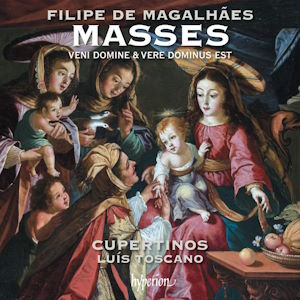
Filipe de Magalhães (c.1563-1652)
Exurge, quare obdormis Domine?
Francisco Guerrero (1528-1599)
Veni Domine
Filipe de Magalhães
Missa Veni Domine
Magnificat primi toni
Pierre de Manchichourt (c.1510-1564)
Vere Dominus est
Filipe de Magalhães
Missa Vere Dominus est
Commissa mea pavesco
Cupertinos/Luís Toscano
rec. 2023, Basilica do Bom Jesu, Braga, Portugal
Hyperion CDA68403 [76]
This disc has strengthened my previous gut instinct: Filipe de Magalhães was a very fine, expressive and skilful composer. The music is presented by a technically capable and eloquent choir, so I feel even more strongly that these are oustanding masses. My only other contact with the composer has been through a 1986 Hyperion release (CDH55138) of his Missa Dilectus meus and a mass by Duarte Lobo. The latter and another Portuguese master Manuel Cardoso seem to have been favoured in recordings over Magalhães.
He came to Lisbon as a singer at the Royal Chapel, and may well have composed a lot of music from his appointment there in 1605 until his death almost fifty years later. But the great Lisbon earthquake in 1755 caused the destruction of a great amount of polyphonic music from the later Renaissance. Some of Magalhães’s works perished at that time. Also, the typeface in the books of Masses and Magnificats published in his lifetime is less distinct than in the publications by his contemporaries.
One cannot know why Magalhães decided to compose a mass on a motet by the Franco-Flemish composer Pierre de Manchicourt, but it is interesting to compare the styles. In Manchicourt’s work, there is that typically complex, close imitation that one hears in the music of his contemporaries Nicolas Gombert and Cristóbal de Morales. Magalhães’s textures in Missa Vere Dominus est – almost a parody – are much more lyrical and expressive. There is occasional homophony, and more emphasis on the top line. Perhaps this was a result of the mood of the times influenced by the edicts of the Council of Trent (held between 1545 and 1563). The beautiful Agnus dei is a good example.
The other mass is based on a motet by Francisco Guerrero, whom Magalhães may have known personally. Missa Veni Domine is a four-part mass for general use with its invocation to ‘Come into the house of the Lord’. It employs liberally various motifs from the motet but – as music director Luís Toscano and musicologist José Abreu tell us in their excellent booklet notes – it concentrates on a brief ostinato in superius II which acts as a unifying element along with the other melodic lines. One notes that there is nothing prolix in Magalhães’s music. His settings are, in fact, compact, with only minimal repetition. For example, Gloria lasts only just over four minutes.
Unusually, the Magnificat is through-composed and not performed in alternatim. The notes say: ‘we have chosen to sing the whole text polyphonically thus using the first-tone version of all twelve verses’. The programme is bookended by two expressive six-part motets, Exurge, quare obdormis Domine? for Sexagesima Sunday, and Commissa mes pavesco for the Office for the Dead.
This is a chance to find out more about Magalhães. I, for one, have not been disappointed. The Cupertinos, as I said in a review of the music by Pedro de Cristo, sing with ‘open vowels, clear tone quality, precise intonation and immaculate diction’. The bio in the booklet suggests that more critics feel the same way.
All Latin texts are provided. As on all Hyperion’s discs of Renaissance music now, each section of each piece is separately tracked. For example, the almost twelve-minute Magnificat has twelve tracks. The photograph of the choir was taken, it seems, in front of the extraordinarily ornate and beautiful classical Basilica do Bom Jesu just outside Braga, which is responsible for the wonderfully clear acoustic.
Gary Higginson
Help us financially by purchasing from




















